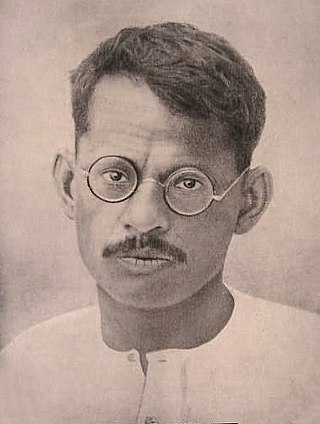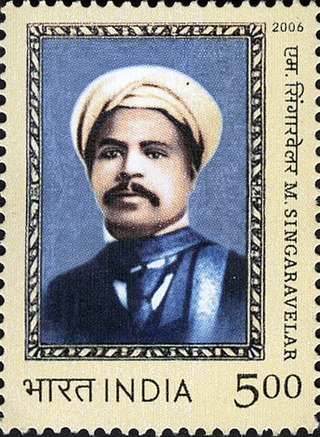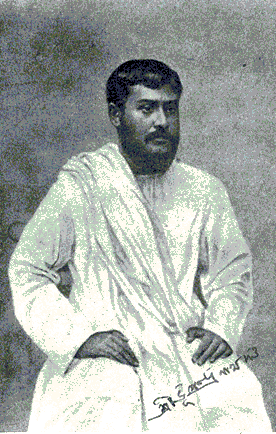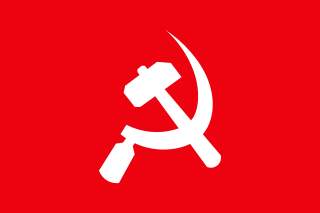
The Communist Party of India (CPI) is the oldest communist party in India. The CPI was founded in modern-day Kanpur on 26 December 1925.In 1964, a split in the CPI caused the formation of the Communist Party of India (Marxist), the largest communist party in India.

Syed Fazl-ul-Hasan, known by his pen-name Hasrat Mohani, was an Indian activist, freedom fighter in the Indian independence movement and a noted poet of the Urdu language. He coined the notable slogan Inquilab Zindabad in 1921. Together with Swami Kumaranand, he is regarded as the first person to demand complete independence for India in 1921 at the Ahmedabad Session of Congress. Maghfoor Ahmad Ajazi supported the complete independence motion demanded by Hasrat Mohani. He wrote the famous ghazal 'Chupke chupke raat din' which was depicted in the 1982 Bollywood movie 'Nikaah' and sung by Pakistani singer Ghulam Ali.

Ganesh Shankar Vidyarthi was an Indian journalist, a leader of the Indian National Congress and an independence movement activist. He was an important figure in the non-cooperation movement and the freedom movement of India, who once translated Victor Hugo's novel Ninety-Three, and is mostly known as the founder-editor of the Hindi language newspaper, Pratap.
The Marxist League was a political grouping in Bombay, India. The League was founded by the middle of 1933 as an open front of the illegal Communist Party of India amongst middle class elements and intellectuals. The League substituted previous associations functioning amongst intellectuals, the 'Marxist Students Club' and the 'Friends of the Soviet Union'. G.V. Haria played a leading role in organising the League. The League ran study classes and arranged public meetings in the city during 1933–1934. Attendees at its meetings included leading communists such as B.F. Bradley, S.V. Ghate, S.S. Mirajkar and K.N. Joglekar.

Malayapuram Singaravelu, also known as M. Singaravelu and Singaravelar, was a pioneer in more than one field in India. In 1918, he founded the first trade union in India. On 1 May 1923 he organised the first ever celebration of May Day in the country. Singaravelar was a major leader of the Indian independence movement, initially under the leadership of Gandhi, but later, joining the budding communist movement. In 1925, he became one of the founding fathers of the Communist Party of India; and chaired its inaugural convention in Kanpur. Though the British Government arrested him along with other leaders on charges of conspiring to wage war against the Crown, he was set free, soon after, on account of his failing health. Singaravelar was also a path-breaking social reformer who in his early life took to Buddhism, seeing it as a weapon against the evil of untouchability, which was particularly severe in the 19th-century India. He was also in the forefront of Self respect movement, in the Madras Presidency that fought for equal rights for backward castes. Though in his advanced years, he withdrew from active politics, Singaravelar remained a staunch advocate of the causes he had pioneered till his death at the age of 85.
Shaukat Usmani (Maulla Bux Usta) (1901–1978) was an early Indian communist, who was born to artistic USTA family of Bikaner and a member of the émigré Communist Party of India (Tashkent group), established in Tashkent in 1920, and a founding member of the Communist Party of India (CPI) formed in Kanpur in 1925. He was also the only candidate to the British Parliament contesting elections, while he was residing in India—that too in a prison. He was sentenced to a total of 16 years in jail after being tried in the Kanpur (Cawnpore) Case of 1923 and later the Meerut Conspiracy Case of 1929.

Bhupendranath Datta was an Indian communist revolutionary and later a noted sociologist and anthropologist. He was younger brother of Swami Vivekananda, and he was also associated Rishi Aurobindo in his political works. In his youth, he was closely associated with the Jugantar movement, serving as the editor of Jugantar Patrika until his arrest and imprisonment in 1907. In his later revolutionary career, he was privy to the Indo-German Conspiracy. The Asiatic Society today holds the Dr. Bhupendranath Datta memorial lecture in his honour.

Socialism in India is a political movement founded early in the 20th century, as a part of the broader movement to gain Indian independence from colonial rule. The movement grew quickly in popularity as it espoused the causes of India's farmers and labourers against the zamindars, the princely class and the landed gentry. After independence and until the early 1990s, socialism shaped some economic and social policies of the Indian government, although they mostly followed the principles of dirigisme. After this period, India moved towards a more market-based economy. Though, India is officially declared a socialist state as per the constitution.
The Workers and Peasants Party (WPP) (also known as the Kirti Kisan Party) was a political party in India, which worked inside the Indian National Congress in 1925–1929. It became an important front organisation for the Communist Party of India and an influential force in the Bombay labour movement. The party was able to muster some success in making alliances with other left elements inside the Congress Party, amongst them Jawaharlal Nehru. However, as the Communist International entered its 'Third Period' phase, the communists deserted the WPP project. The WPP was wound up, as its leadership was arrested by the British authorities in March 1929.

Philip Spratt was a British writer and intellectual. Initially a communist sent by the British arm of the Communist International (Comintern), based in Moscow, to spread Communism in India, he subsequently became a friend and colleague of M. N. Roy, founder of the Communist parties in Mexico and India, and along with him became a communist activist.

Communism in India has existed as a social or political ideology as well as a political movement since at least as early as the 1920s. In its early years, communist ideology was harshly suppressed through legal prohibitions and criminal prosecutions. Eventually, communist parties became ensconced in national party politics, sprouting several political offshoots.

Swami Satyabhakta was an Indian scholar, philosopher, reformer and the founder of Satya Samaj.
Suhasini Chattopadhyay was an Indian communist leader and a freedom fighter. She was the first woman member of the Communist Party of India.

Bal Krishna Sharma, known under the pen name Naveen, was an Indian freedom activist, journalist, politician and a poet of Hindi literature. He was a member of the 1st Lok Sabha, representing Kanpur constituency and served the Rajya Sabha as a member from 1957 till his death. He succeeded Ganesh Shankar Vidyarthi as the editor of Pratap daily and also served as a member of the Official Languages Commission. His poetry anthologies include Kumkum, Rashmirekha, Apalak, Kwasi, Vinoba Stavan, Urmila and Hum Vishpaee Janam Ke, the last one published posthumously. The Government of India awarded him the third highest civilian honour of the Padma Bhushan, in 1960, for his contributions to literature. India Post issued a commemorative stamp on Sharma in 1989.
Sachchidanand Vishnu Ghate, also known as S.V. Ghate, was a freedom fighter and first General Secretary of the Communist Party of India. The Communist Party of India Karnataka State headquarters, Ghate Bhavan, is named in his honor.

The Communist Party of India is one of the oldest political parties in India. However within the Indian communist movement, there is a controversy on what date to consider as the foundation date of the party. The early history of the Indian communist movement was tumultuous and complicated. An Indian communist group emerged in Tashkent in 1920, led by M. N. Roy. From 1921 onward small local communist groups began to emerge inside India. A national communist conference was held in Kanpur in 1925. The efforts to build a Communist Party organization inside India were hampered by arrests and court cases against leading party members.
The Kanpur Bolshevik Conspiracy Case was a controversial court case initiated in British India in 1924.

Ganesh Shankar Vidyarthi was an Indian independence activist and politician from Nawada district in the state of Bihar. He was elected to the Bihar Legislative Assembly for two terms and he was a Member of the Bihar Legislative Council for one term. He joined the Communist Party in 1942 and went on to become the State Secretary of the Communist Party of India (Marxist) as well as a member of its national Central Committee. He went to jail multiple times for a total of six years both before Independence and after due to his political participation. He was fondly called Ganeshda.

K. N. Joglekar was an Indian politician and one of the founding members of Communist Party of India. Then he joined All India Forward Bloc. He became the General Secretary of the All India Forward Bloc from 1948 to 1952. Then he formed Forward Communist Party; in 1952 this party merged with the Communist Party of India.
Communists were actively involved in Indian independence movement through multiple series of protests, strikes and other activities. It was a part of revolutionary movement for Indian independence. Their main thrust was on organising peasants and working classes across India against the British and Indian capitalists and landlords.










